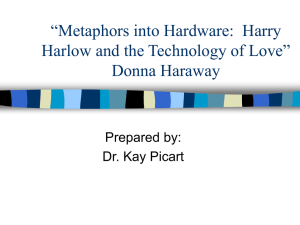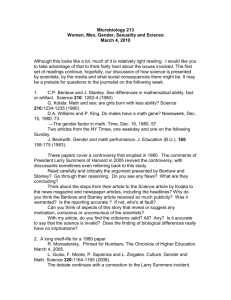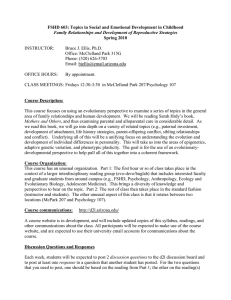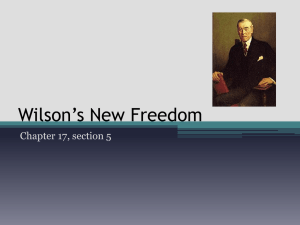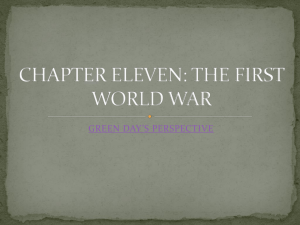Sociobiology according to Sarah Blaffer Hrdy
advertisement
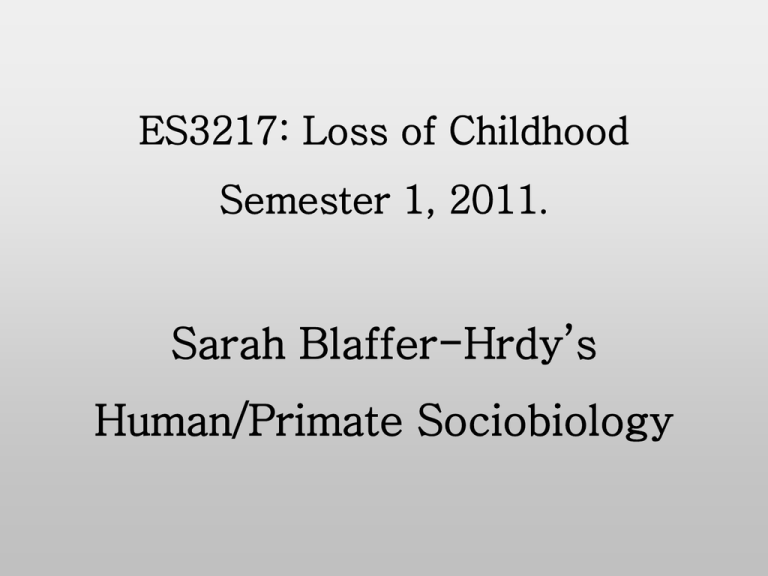
ES3217: Loss of Childhood Semester 1, 2011. Sarah Blaffer-Hrdy’s Human/Primate Sociobiology As discussed last week, Wilson’s decision to include human beings in his account of Sociobiology caused an academic scandal in the United States: the equivalent ‘scandalous’ publication in the U. K. was Richard Dawkins’ The Selfish Gene, published before Wilson’s and making much less specific claims about humanity. As a result of the furore, many academic authors preferred to distance themselves from Wilson’s ‘synthesis’, although broadly accepting most of his argument. This more palatable form of sociobiology is now usually called evolutionary development theory – or ‘evo-devo’ for short. The principal change in theorising about human beings, compared with Wilson’s account, is that evo-devo offers a specific substitution for the difficulties of incorporating human experiments in a Wilsonian synthesis. It achieves this by incorporating the fruits of speculative studies in human evolution. Whereas Wilson could identify thousands of examples from which to base his theorising about the social insects, human beings appear to be unique in ways that seem highly significant! Wilson tried to get round this difficulty by making comparisons with other primates, using what demographic and genetic information was then available, but even he conceded that human culture and language introduced a major stepchange that could not be simply ignored. In fact, he made it even harder for himself: you may recall that he had a particular notion of what counted as ‘real’ theory. The solution to the experimental problem of there being no ‘real’ theory within anthropological study, and no real comparison with related animals, was solved by scientist working within the evo-devo paradigm by making evidence-based conjectures of our ancestors’ Pleistocene life style. However, Sarah Blaffer-Hrdy has resolutely insisted that her work is sociobiological. She follows a long line of mainly American researchers (predominantly female), who believe that the study of the living primates and their social lives is a powerful source of illustration and comparison – one that Wilson did not fully appreciate at the time he prepared his first version of Sociobiology. Along with this deepening of the demographic perspective, she includes three further sources of information: physiology (see her account of lactation), anthropology (see her references to the !Kung), and selected items of evo-devo (see her comments on concealed menstruation). But it is at this very reasonable point that one has to throw a spanner into the works! The science historian, Donna Haraway, has written extensively on the American fascination with primate study in her 1989 publication, Primate Visions. Haraway is not an ‘easy read’, but in this book she presents a trenchant critique of the gender stereotypes that characterise much of this work. your Haraway photocopy argues that facts are made, not simply found – Wilson said as much. In relation to Blaffer-Hrdy, Haraway argues that ‘Hrdy’s map of differences*, her way of narrating that females – and women – differ from each other and are therefore agents, citizens, and subjects in the great dramas of evolution and history, is perhaps more a guide to the cultural logic of late capitalism than to the prefigurative fictions and material practices of international multicultural feminisms’ (Haraway, 1987: 350). *by ‘differences’ here Haraway is referring to Hrdy’s liberal individualism ‘extracted’ from the primate female body. Haraway offers an analysis of sexual politics in the United States, circa 1970-80, relating to abortion, sterilisation, birth control, population policy, high-tech reproductive interventions, wife-beating, child abuse, family policy, definitions of family, the sexual political economy of aging, the science and politics of diet ‘disorders and regimes, the shift from nuclear family-based patriarchy to the state in welfare policy, divorce rates and the gender unequal consequences thereof, sexual identity politics, rape, pornography, trans-sexuality, foetal and child purchase through surrogacy, racist sexual exploitation, etc. Her point is that since liberal individualism has axes to grind in every one of these contested debates, ‘What principle of order could reduce such a list to coherence?’ So Haraway provides an overview of Hrdy’s work, and the work of other primatologists, but for our purposes, we need only focus on a few aspects of Hrdy’s project. The following extract introduces these:- If we recognise that a female’s reproductive success can depend in critical ways on the tolerance of nearby males, on male willingness to assist an infant, or at least to leave it alone, the selective importance of an active, promiscuous sexuality becomes readily apparent. Female primates influence males by consorting with them, thereby manipulating the information available to males about possible paternity. To the extent that her subsequent offspring benefit, the female has benefited from her seeming nymphomania’ (Hrdy, 1981: 174).1 1The Woman that Never Evolved. Haraway’s concludes that essentially Hrdy is identifying a number of ‘investment’ strategies that imply the existence of a constant war between the sexes played out, in the case of humans, through language and social practice. But there is no reason why her critique should be yours. The three photocopies selected in order to give you more detailed insight into Hrdy’s project are as follows. From her earlier and more comprehensive book, Mother Nature, selections from chapter 1, ‘Motherhood as a Minefield’, and chapter 23, ‘Alternate Paths of Development’. From her later book, Mothers and Others, only chapter 9, ‘Childhood and the Descent of Man’.


